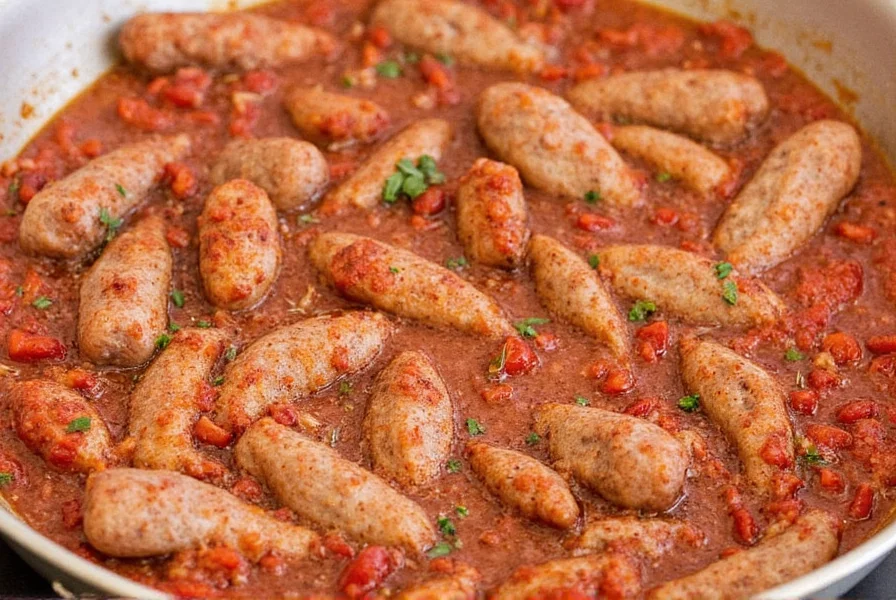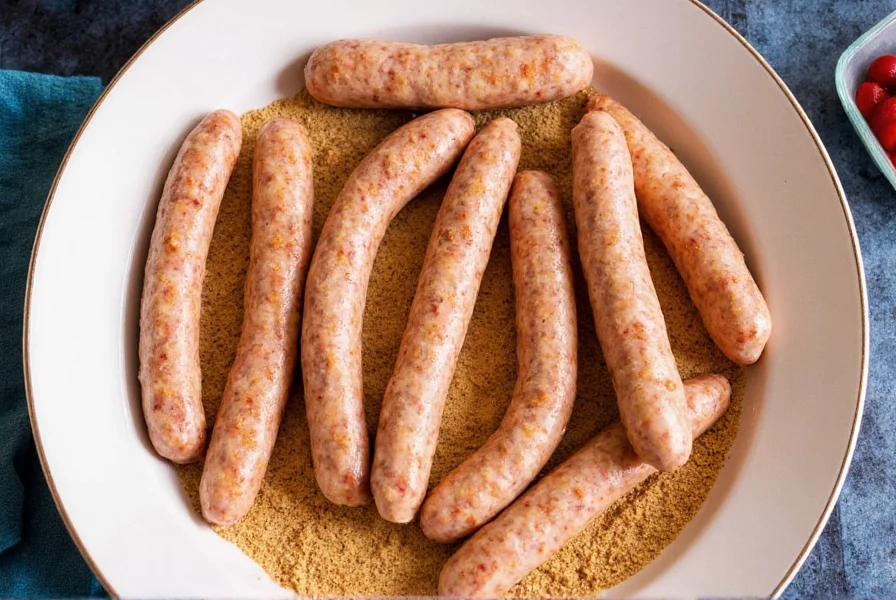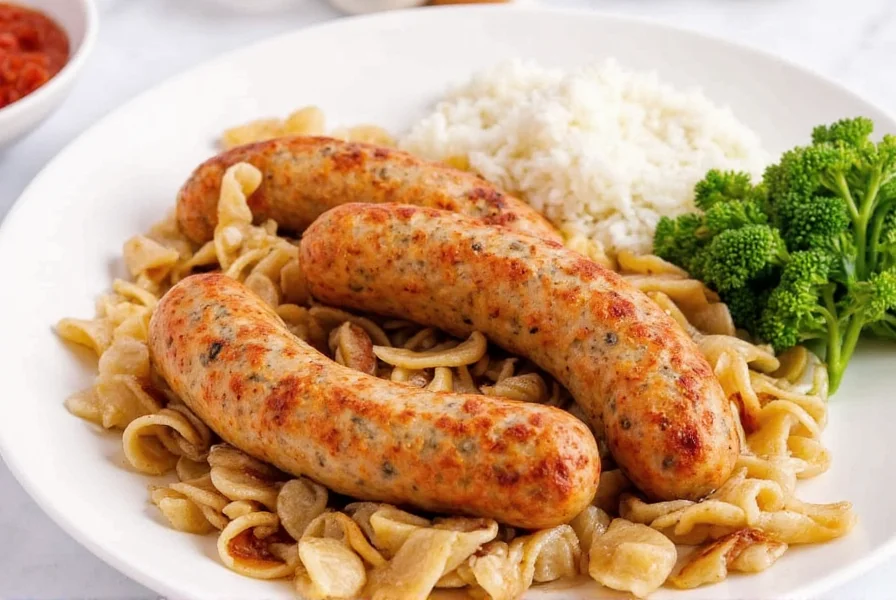Easy Chicken Sausage Seasoning Recipe (Ready in 5 Minutes)
Here's the perfect chicken sausage seasoning recipe: combine 1 tsp salt, 1/2 tsp black pepper, 1 tsp garlic powder, 1 tsp onion powder, 1 tsp paprika, 1 tsp dried thyme, and 1/2 tsp crushed fennel seeds. Mix with 1 lb ground chicken, add 1 tbsp lemon juice and 1 tbsp olive oil (optional), then cook to 165°F for juicy, flavorful sausages every time.

Why Chicken Sausage Needs Special Seasoning
Unlike fattier meats like pork, chicken is lean and neutral in flavor. This means it needs a bit more love when it comes to seasoning. A well-balanced chicken sausage seasoning should enhance the natural taste of the meat without overpowering it.
Lean Meat Needs Flavor Boosters
- Garlic powder adds depth
- Paprika brings color and mild heat
- Fennel seed gives that classic sausage feel
- Lemon zest brightens up the whole mix

Top 7 Essential Spices for Chicken Sausage Seasoning
- Salt – Enhances overall flavor and helps bind the meat
- Black Pepper – Adds warmth and bite
- Fennel Seed – Classic sausage note; slightly licorice-like
- Garlic Powder – Sweet, savory, essential
- Paprika – Smoky or sweet, depending on your style
- Onion Powder – Balances and deepens flavor
- Thyme or Sage – Herbs add earthiness and freshness

| Feature | DIY Seasoning | Pre-Mixed Seasoning |
|---|---|---|
| Customization | High (mix your own) | Moderate (pre-set ratios) |
| Flavor Control | Full control | Less flexible |
| Convenience | Requires time and ingredients | Quick and easy |
| Shelf Life | Lasts months if stored properly | Varies by brand |
| Price | Cost-effective long-term | More expensive per use |

Secret Ingredients That Make Your Chicken Sausage Pop!
Beyond the basics, adding a few unexpected ingredients can take your sausage game to the next level:
- Lemon zest – Brightens up the meat
- Worcestershire sauce – Adds umami depth
- White wine – Infuses subtle complexity
- Citrus juice – Especially orange or lemon
- Dijon mustard – For a tangy twist
Pro Tip:
Add a small amount of fat (like butter or olive oil) to keep the sausage moist and juicy. Since chicken is lean, a little added fat makes a big difference in texture.

Buying Guide: Choosing the Best Chicken Sausage Seasoning Brands
If you don't have the time or ingredients to make your own, here are some top-rated commercial seasonings for chicken sausage. Each has its own unique profile and use case:
| Brand | Flavor Profile | Best For | Usage Tips | Occasions |
|---|---|---|---|---|
| Spicely Organics | Mildly spiced with Mediterranean herbs | Beginners and health-conscious cooks | Mix with ground chicken and stuff into casings or form into patties | Weeknight dinners, family meals |
| Badia | Peppery with Latin American flair | Those who enjoy bold, spicy flavors | Use in soups, stews, or grilled dishes | BBQs, parties, Latin-inspired recipes |
| Rex Foods | Classic Italian-style seasoning | Traditionalists and Italian food lovers | Ideal for pasta sauces, pizzas, and antipasti platters | Italian-themed meals, dinner parties |
| McCormick Sausage Maker | Smoky and robust | Home sausage makers and grilling enthusiasts | Pair with a meat grinder and casing kit | Outdoor cooking, tailgating, weekend projects |

Troubleshooting Common Seasoning Mistakes
Even the best intentions can lead to a bland or overly spicy sausage. Here's how to fix common issues:
- Too salty? Add breadcrumbs or more chicken to dilute the salt.
- Too spicy? Balance with dairy like yogurt or sour cream when serving.
- Not enough flavor? Add acid (lemon juice), herbs, or a splash of vinegar before cooking.
- Too dry? Add a small amount of oil or egg white to help bind and moisturize the meat.
Variations: Regional Twists on Chicken Sausage Seasoning
Why stick to one flavor? Try these exciting regional variations to give your chicken sausage a global flair:
- Spanish Style: Smoked paprika, garlic, sherry vinegar, saffron
- Thai-Inspired: Lemongrass, ginger, fish sauce, chili flakes
- Mexican Fiesta: Cumin, coriander, chipotle, lime zest
- Herb Garden: Rosemary, thyme, parsley, garlic
- Cajun Heat: Cayenne, paprika, garlic, onion powder, oregano

Storing and Using Leftover Seasoning
You'll likely have extra seasoning mix after making a batch of sausages. Store it in an airtight container away from light and moisture. Most blends last 6–12 months.
- Use as a rub for chicken breasts or thighs
- Season burgers or meatloaf
- Enhance grain bowls or roasted vegetables
- Add to lentils or bean dishes for a meaty kick

Frequently Asked Questions About Chicken Sausage Seasoning
What are the essential spices for chicken sausage seasoning?
The essential spices for chicken sausage include salt, black pepper, fennel seed, garlic powder, paprika, onion powder, and herbs like thyme or sage. Chicken is leaner and more neutral in flavor than pork or beef, so it needs a balanced seasoning blend that enhances rather than overwhelms the meat.
How much seasoning should I use per pound of chicken?
For best results, use about 1-2 tablespoons of seasoning blend per pound of ground chicken. Start with 1 tablespoon, mix well, and do a small test fry to check the flavor. You can always add more seasoning, but you can't take it away once it's mixed in. Remember that different seasonings have varying intensities, so adjust accordingly.
Can I use the same seasoning for chicken sausage as I would for pork sausage?
While you can use similar seasonings, chicken sausage typically needs a lighter hand with stronger spices. Pork has more fat and a stronger flavor that can stand up to robust seasonings, whereas chicken's delicate flavor can be easily overwhelmed. You may want to reduce the amount of potent spices like cayenne or garlic when making chicken sausage compared to pork sausage.
How can I make my chicken sausage less dry?
Since chicken is leaner than pork, dryness is a common issue. To keep your chicken sausage moist: 1) Add 1-2 tablespoons of olive oil or butter per pound of meat, 2) Include moisture-rich ingredients like grated apple or zucchini, 3) Don't overmix the meat (this develops proteins that make sausage tough), and 4) Cook to 165°F but don't overcook. The acid from ingredients like lemon juice or vinegar also helps tenderize the meat.
What's the best way to store chicken sausage seasoning?
Store homemade chicken sausage seasoning in an airtight container away from light, heat, and moisture. Glass jars with tight-fitting lids work well. Properly stored, most seasoning blends will maintain their potency for 6-12 months. Check for freshness by smelling - if the spices no longer have a strong aroma, it's time to make a fresh batch.
How long should I let the seasoned chicken rest before cooking?
For best flavor development, let the seasoned chicken mixture rest in the refrigerator for at least 30 minutes, or up to 24 hours. This allows the flavors to meld and the salt to penetrate the meat, improving both taste and texture. If you're using casings, the resting time also helps the meat bind together better for easier stuffing.
Final Thoughts: Elevate Your Cooking with the Right Chicken Sausage Seasoning
Mastering chicken sausage seasoning isn't just about throwing together a few spices. It's about understanding balance, flavor profiles, and how ingredients interact with lean meat. With a little practice, you'll be crafting sausages that impress even the pickiest eaters at your table.
So go ahead — experiment, adjust, taste, and enjoy. Your next batch could be the best one yet!












 浙公网安备
33010002000092号
浙公网安备
33010002000092号 浙B2-20120091-4
浙B2-20120091-4